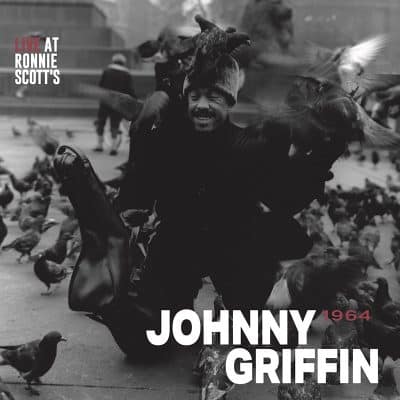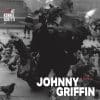Johnny Griffin Live at Ronnie Scott’s 1964
 Johnny Griffin
Johnny Griffin
Live at Ronnie Scott’s 1964
Gearbox
This latest discovery hit with little warning, but true audiophiles and tenor sax aficionados may already be hip to this this latest offering from Gearbox – Johnny Griffin’s Live at Ronnie Scott’s 1964. This white-hot set has already issued on digital, CD, standard, limited edition, and Japanese edition vinyl. Essentially, the album centers on three long tracks of the 15 to 21-minute variety as Griffin, also known as Little Giant, cedes nothing to Sonny Rollins or John Coltrane in terms of his lengthy, inventive soloing though his is rooted in the earliest stages of hard bop, as Griffin takes to his horn with speed defying rapidity.
At the time Griffin was just 35 years old, having cemented his reputation with Lionel Hampton’s band, which led the Chicagoan to New York where he played with Thelonious Monk and Art Blakey’s Jazz Messengers recording for both Riverside and Blue Note. Without getting into a long chronology, Griffin touched so many bases, beginning in blues bands of T-Bone Walker, Wynonie Harris, and Arnett Cobb, his discography includes these greats: Dexter Gordon, Charles Mingus, Dizzy Gillespie, Eddie Jefferson, Wes Montgomery, Blue Mitchell, Nat Adderley, Randy Weston, Eddie “Lockjaw” Davis, and more.
Following a move to France where Griffin was a major soloist in the all-star big band led by pianist Francy Boland and drummer Kenny Clarke, Griffin returned to Ronnie Scott’s for the second time in 1964, having appeared there in 1962. Griffin fronted a quartet of well-known players on the British jazz scene at the time – pianist Stan Tracey, bassist Malcolm Cecil, and Scottish drummer Jackie Dougan, the latter a member of the Ronnie Scott Quartet.
Readers of this writer’s ‘generation’ may recall the 1977 buzz surrounding the “Homecoming” concert of Dexter Gordon and Griffin at Carnegie Hall, later released under Dexter Gordon’s name – Homecoming (Columbia, 1981). This writer was privileged to attend their performance at the Eclipse Jazz Festival in Ann Arbor and interview both tenor giants along with Michael Cuscuna and several others for a later airing on NPR prior to their Carnegie Hall appearance. Griffin would have been around 48 at the time, still incredibly vital but shy of the intensity we hear in this incomparable recording where he was the lone horn.
Griffin makes an emphatic low register entrance after just a few bars for “The Girl Next Door,” a track originally written by Hugh Martin as “The Boy Next Door” for the film Meet Me in St. Louis (sung by Judy Garland). Less than a minute half into his solo, Griffin reaches into the upper registers with blazing speed, eventually taking the tune to a ridiculously fast tempo, never relenting, except to cede brief solos to his rhythm mates around the six-minute mark. Following that six- minute sequence almost to the second, Griffin blasts back in, building his solo gradually to burning levels, capping it with one sustained note.
The album highlight and a track that may eventually go down in lore as one of the greatest tenor solos on record (sounds hyperbolic but judge later after listening) is Griffin’s 21 minute plus take on the bebop classic “(Back Home in ) Indiana,” a tune that fits with the likes of “Donna Lee” (Miles Davis and Clifford Brown) and “Ice Freezes Red” (Fats Navarro) that has appropriately become the theme for the Indianapolis 500. Griffin takes this at a scorching 80 bars (or 320 beats) per minute in an endless stream of ideas that runs through all 12 keys, to a rousing ovation in both of his fierce, extended turns. Drummer Dougan is quite impressive here as well, especially on the snares. Griffin moves through several exchanges with Dougan on the eights, leaving the drummer room to solo as well, as they take it out to a surprisingly abrupt close.
Rather naturally, Griffin steps down from this blistering tempo to a more basic R&B-like honking blues that dates to his earlier work with Wynonie Harris and Sticks McGhee. Yet, there are still sequences where both his dazzling speed and generous spewing of ideas are jaw-dropping. For the close he moves through Miles Davis’s “The Theme” with a machine gun spray of notes in little over a minute, as many notes as it would take most three times as long to deliver.
Fasten your seatbelts. Griffin’s intense tenor playing, especially on “(Back Home in) Indiana” belongs in the same conversation with Coltrane’s “Chasin’ the Trane,” Sonny Rollins’ “Tenor Madness,” or Sonny Stitt’s “Eternal Triangle.
Jim Hynes
Buy Us a Cup of Coffee!
Join the movement in supporting Making a Scene, the premier independent resource for both emerging musicians and the dedicated fans who champion them.
We showcase this vibrant community that celebrates the raw talent and creative spirit driving the music industry forward. From insightful articles and in-depth interviews to exclusive content and insider tips, Making a Scene empowers artists to thrive and fans to discover their next favorite sound.
Together, let’s amplify the voices of independent musicians and forge unforgettable connections through the power of music
Make a one-time donation
Make a monthly donation
Make a yearly donation
Buy us a cup of Coffee!
Or enter a custom amount
Your contribution is appreciated.
Your contribution is appreciated.
Your contribution is appreciated.
DonateDonate monthlyDonate yearlyYou can donate directly through Paypal!
Subscribe to Our Newsletter
Discover more from Making A Scene!
Subscribe to get the latest posts sent to your email.














































